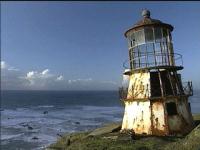 We recently posted about three killer lighthouses. It turns out that lighthouse keepers had more to worry about than simply storms and terrible conditions. In the 19th century, lighthouse keepers had a high frequency of madness and suicide. Many assumed that they went mad from solitude and the demands of the job. It turns out it was something simpler and more sinister.
We recently posted about three killer lighthouses. It turns out that lighthouse keepers had more to worry about than simply storms and terrible conditions. In the 19th century, lighthouse keepers had a high frequency of madness and suicide. Many assumed that they went mad from solitude and the demands of the job. It turns out it was something simpler and more sinister.
Fresnel lenses were the great lighthouse innovation of the 19th century. The lenses developed by French physicist Augustin-Jean Fresnel greatly increased the intensity and range of the lighthouse beacon. For rotating lights, just as importance as the strength of the light, however, was maintaining a specific speed of rotation, so that if the chart said that the light flashed every twenty seconds, the light, in fact, rotated so that the light was visible every twenty seconds. The best near zero-friction bearing of the day was created by floating the light and the lens on a circular track of liquid mercury. When dust, dirt or other impurities built up in the mercury, part of the light house keeper’s job was to strain the mercury through a fine cloth.
Though not understood at the time, mercury is a deadly poison. One of the symptoms of mercury poisoning can be the onset of madness. Those involved in the manufacture of hats in the 18th and 19th centuries also suffered from mercury poisoning, becoming as “mad as a hatter” as the old saying went. Like the hatters of their day, the light house keepers were being driven mad by exposure to mercury fumes. The solitude was not driving the lighthouse keepers mad. They were being poisoned by the lighthouse itself. Perhaps we should add “mad as a lighthouse keeper” to the lexicon.

Hatters and keepers. Innocent enough names for maddening professions.
In Scotland we also had the Flannan Isles incident:
http://sjhstrangetales.wordpress.com/2012/01/10/the-flannan-isles-lighthouse-mystery/
For those interested in lighthouses I must recommend “The Lighthouse Stevensons” by Bella Bathurst.
Hence Lewis Carroll’s “Mad Hatter.” Interesting.
Alas, Today’s lighthouses are un-manned
Ironically Mercury is in Compact Fluroescent Lamps, CFL’s, endemic to
today’s homes
Mercuy is still used in Manometers. However, today there are non-
mercury substitues for manometery. Today’s Submarines are Mecury Free.
Years ago, Mercury Seals were used in Sewage Plant Comminuters
Gasoline is lead Free.
And i don’t thinks kids drink garden hose water, their helicopter parents wont stand for it.
What will our New life expectnacies be?
Pingback: Why did lighthouse keepers go mad? | Dj Matioka Blog
As a kid, I used to play with mercury and asbestos cloth, melt lead on the spare stove in the basement, ride my bike behind the mosquito fog truck, make my own gunpowder and I survived to be 57 years old; except I now have three eyes and grew moose antlers and an extra arm.
In all seriousness, the things I was exposed to were minimal but I am sure if I spent more time around them I’d be dead by now.
Pingback: I have seen the light. – Ceeeni's Blog